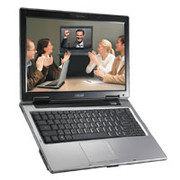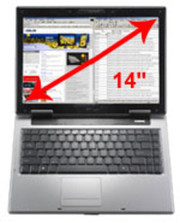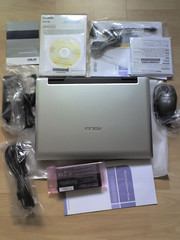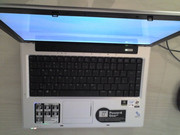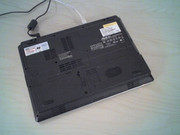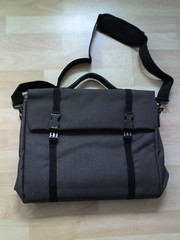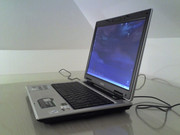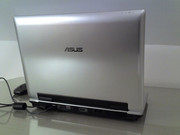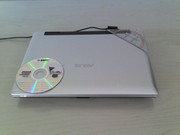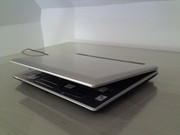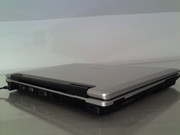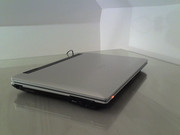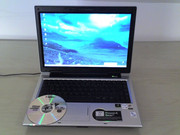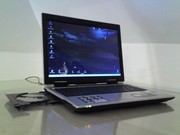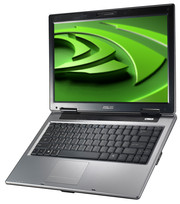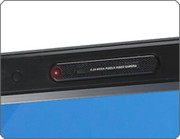User-Review Asus A8JS
Requirements of my new notebook
At the beginning of the new term I was in the need of an up to date notebook. The notebook should have sufficient performance to use CAD applications and once in a while games, because I am at the Campus during the day. Furthermore, my hobby is developing games. Therefore, the new notebook needs an excellent video card. At the same time, it should be light and small, to be carried in my knapsack. Although my budget was small, I wanted to buy a notebook which uses future-proof technology and which therefore can be used for the next 4 to 5 years.
Purchase Decision
My shortlist consisted of Macbook Pro 15'', DELL XPS M1210 and DELL Inspiron 6400. The Apple notebook was ruled out, because it was not available with a Core Duo 2 processor. (Although there are models with Core 2 Duo processor available now, their video card (ATI X1600) still does not justify their price). Regarding design and weight DELL's XPS M1210 was interesting, but its video card and its price did not convince me. Inspiron 6400 seemed to have a good price-performance ratio. I nearly ordered it, but the ATI X1400 video card did not convince me. Fortunately, ASUS introduced its A8JS a short time before I was to order the DELL notebook: It is a 14'' notebook with an up to date CPU, much RAM and a fast video card- altogether for only ~1650€ (at the time I ordered, price are on the decrease).
Scope of supply
- ASUS A8JS
- ASUS notebook bag (with carrying strap)
- ASUS optical mouse
- ASUS Recovery CD (including XP Professional)
- cable for S-Video
- modem cable
- further CDs with software and some handbooks.
Software
- Windows XP Professional (unfortunately not the 64 bit version)
- Nero v6.6.1.7
- Norton Internet Security
- Skype
- some ASUS specific applications
Design and Workmanship
It has a robust plastic case. One can push it in only at a few places at inner side at the edge of the display and next to the touch pad. It is not possible to push it in at the outer side. If closed, the lower left corner of the display can be slightly moved. In total it still seems robust and to be carried at no risk. When picking up the notebook at the bottom side, one must take care of the left upper side, because there is the DVD drive, but one gets used to it.
It has a pleasant design and is suggestive of professionalism. The hot keys (which provide useful functions) and the "on"-switch are above the keyboard. The nibbles ensure skid resistance even on slanting surfaces (which is useful in our lecture rooms). One cannot use any keys, if the notebook is closed; only the LEDs in the lower left corner indicate the notebook's status. This fits well in the overall design. Well, I don't like the sticks, which are placed nearly everywhere at the notebook, but one can remove them.
Input devices
The keyboard is steady in the case and the keys do not show any deflections. I want to mention that its quality is not as good as the quality of IBM's or Apple's keyboards, because it sometimes clatters during typing. But the keys are reasonably ordered and the keyboard can also be comfortably used for longer duration.
I was personally annoyed that the FN key instead of the CRTL key was placed at the bottom left. But this is a matter of taste. The touch pad convinced me at once: It consists of only one plate, which is at the same level than the rest of the case. Therefore it is easy to clean (even the small dust particles can be easily removed). At the first, the surface of the touch pad seemed to be a little bit coarse, but its response is good. It takes getting used to the vertical scrolling (e.g. if browsing through a longer document): One has to slide down the finger close to the right mark, but not on it. The distance must be correct, otherwise one can't fluently scroll. One has to practice for finding the right distance. Alternatively, one can configure a broader scroll region in the touch pad driver.
The optical mouse has a short cable and a compact design and is especially designed for mobile use. Its design fits well to the design of the notebook. It is suitable for applications and games. Therefore, it is unnecessary to separately buy another mouse.
Carrying bag
The carrying bag is made of nylon. It consists of two main compartments and a further one, which can be closed by a zipper, at the backside. The handle is made of leather; the carrying strap is connected by two metal parts. It's of low weight and of compact size, so it is ideal for comfortably carrying the notebook and the most necessary accessories.
Display
The display is well illuminated and can be controlled easily by Fn keys. Even if the display reflects, this is not disturbing under normal lightening conditions. But one should avoid powerful sources of lights from the back. Good contrast and colors make it an ideal display for watching DVDs and playing games. Horizontally, the stability to the vantage point is excellent. Vertically, it is still alright, although the display looks brighter, if looking from top to down and quickly gets nearly black, if looking from bottom up. Once the display is black, one can observe a bright region at the lower part. This is a hint that the main source of illumination is in the bottom region (but it is not that heavy - so it does not disturb).
Sound / Speakers
In contrary to the display and the rest of the equipment, which makes it a real multimedia notebook, the quality of the speakers are rather moderate. The basses are weak. The speakers are foolishly placed at the bottom side near the front (considering the design, it does not seem to fit anywhere else). If one is typing, the hands muffle the already poor sound even more. In order to listen to music or watch films I would recommend the use of a headset.
DVD Writer
The drive writes DVD/DVD-R (even Double Layer) with a speed of up to 8x. It is at the left side and therefore does not disturb, if there is a mouse connected at the right side. During initialization and reading, there is an annoying noise; during watching DVDs the noise is alright. The eject button is not placed handy.
Ports
The notebook comes with Gigabit Ethernet, integrated modem, WLAN, Infrarot and Bluetooth. Even the number of further ports are comparable to 17'' notebooks: 5xUSB 2.0, 1xFirewire and an Express Card Slot, a Card Reader and a variety of connections of the video card (VGA, DVI, S-Video). It's amazing, how many ports are available in such a small space. Still it weights only 2.4kg.
Performance
The reason why I purchased the A8JS was its outstanding performance together with a price that was clearly below 2000 €. Intel Core Duo 2 2GHz, 2GB RAM memory, GeForce7700 and a 120GB hard disk: The 14'' notebook seemed to be nearly a DTR. Subjectively everything runs fluently and fast. Following there are some benchmarks (Norton Internet Security and MSN/Skype/... ran in the background, everything else was like the system was delivered):
3DMark
I performed the benchmark with the profile "Super Performance" of Power4Gear (ASUS's tool for power and performance control), once with the default setting ( "Quality") of the NVIDIA Panel and once with "High Performance":
| 3DMark 03 Standard | 10176 points | |
| 3DMark 05 Standard | 4279 points | |
| 3DMark 06 Score Unknown Setting | 2671 points | |
Help | ||
The values comply with those of the video card benchmark.
Super Pi
It checks the CPU/RAM performance, by calculating many decimals of PI.
1Mio decimals: 0.25 min
2Mio decimals: 1.01 min
4Mio decimals: 2.21 min
Aquamark03
This benchmark is a little bit older and checks the CPU/RAM and video card performance. I performed the test with "Quality" | "High Performance".
TPS: 20991462 | 21779858
FPS: 69,73 | 72,35
GFX: 10164 | 10731
CPU: 11109 | 11099
ALL: 69731 | 72350
Cinebench
This benchmark is based on Cinema4D and renders 3D scenes. Again the values for "Quality" | "Performance"
Rendering (Single CPU): 330 CB-CPU | 329 CB-CPU
Rendering (Multiple CPU): 607 CB-CPU | 604 CB-CPU
Multiprocessor Speedup: 1.84 |1.84
Shading (CINEMA 4D): 394 CB-GFX | 394 CB-GFX
Shading (OpenGL Software Lighting): 1418 CB-GFX | 1427 CB-GFX
Shading (OpenGL Hardware Lighting): 3540 CB-GFX | 3093 CB-GFX
OpenGL Speedup: 8.98 | 8.98
X3 Rolling Demo
This demo can also be run in benchmark mode and checks CPU/RAM and video card performance. I used the default setting for resolution etc. in the NVIDIA Control Panel I selected "High Performance".
Scene 00 44.6 average fps 37.0 minimum fps 64.0 maximum fps
Scene 01 36.9 average fps 16.0 minimum fps 80.0 maximum fps
Scene 02 43.0 average fps 33.0 minimum fps 60.0 maximum fps
Scene 03 58.5 average fps 40.0 minimum fps 123.0 maximum fps
Overall average framerate: 45.8 fps
Game performance
The playable X3 DEMO with native resolution (1440x900) and all details (AA off) ran besides the intro fluently (even the fights).
Lego Starwars 2 Demo ran fluently with everything set to maximum and Antialiasing, even with two players.
Guild Wars ran fluently with all details. At 2x and 4x AA the FPS fell down a little bit, but still stayed permanently above 30FPS.
Gothic 3 ran at a resolution of 1280x800, medium details and Shader Model 3.0 nearly always fluently and is my favorite game. The loading time of the game is about 1min.
CAD applications
Even complex components can be changed, moved or rotated fluently in CATIA v5. 2GB RAM and a excellent video card are worth it. The reaction speed, if selecting components, is fast. The high resolution makes it easy to keep the complete picture. If started the first time after a reboot, CATIA needs about 1 min. to start. All other starts take up about 8s, which is excellent compared to desktop PCs. The notebook is therefore well suitable for CAD and constructions applications.
Battery Runtime
A8JS comes with Power4gear, which is a tool for controlling energy demand and performance. One can conveniently switch between the different modes by using hot keys. In order to be able to predict the battery runtime under nearly all circumstances, I made two test, which differs greatly. During the idle test, I turned down the brightness and used the option "Battery Saving", I turned off WLAN and Bluetooth, no USB devices were connected and the NVIDIA PowerMizer was configured at "Minimum Energy Demand". For the second test I selected "High Performance", turned on WLAN and Bluetooth and connected a USB mouse. The NVIDIA PowerMizer was configured at "Maximum Performance" and I used the internal speakers.
These are the results:
Laufzeit idle: ~3:30h (210min)
Laufzeit Last: ~1h (60min)
Recharging of the battery (notebook switched off): 140min
The real battery runtime should be between these values. There is a big difference between the maximum and the minimum runtime, because the notebook comes with high-end components and because the power saving option allows to save a lot of energy. I was pleased to discover that the hardware does not necessarily run at a lower clock rate in battery mode.
Temperature / fans
Surprisingly, the fans run all the time, even in idle mode, although the temperature is within its bounds, but it does not disturb. The temperature increases only slightly: Even when using demanding applications for a longer time, only the region under the right hand gets slightly warmer. Even the bottom side is not getting too hot, so that one can use the notebook without problems on the lap.
Verdict
I was convinced by the professional equipment, the outstanding performance, a mobile design and the price. Besides excellent standard equipment, the notebook comes with a good touch pad, an integrated web cam and convinces through the quality of its accessories (optical mouse, bag). It has a lot of ports compared to other 14'' notebooks.
Weak point are the moderate speakers and the loud DVD drive. The notebook should maybe come with a 64 bit XP, because the Core Duo 2 Prozessor would profit. To my opinion, ASUS could create a mobile notebook with outstanding performance at the same time and a reasonable price.


 Deutsch
Deutsch English
English Español
Español Français
Français Italiano
Italiano Nederlands
Nederlands Polski
Polski Português
Português Русский
Русский Türkçe
Türkçe Svenska
Svenska Chinese
Chinese Magyar
Magyar
